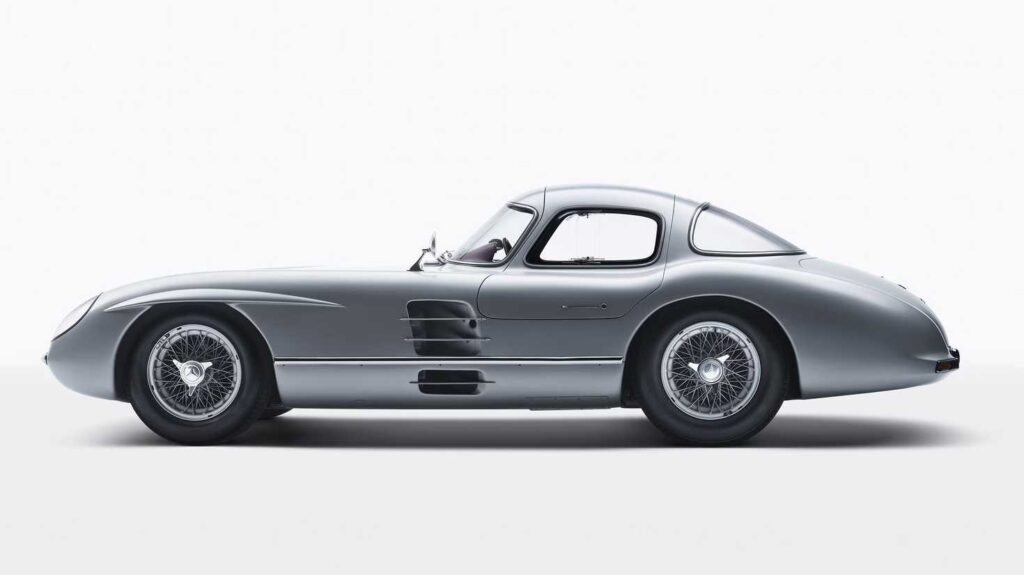In the world of automobiles, there are cars, luxury cars, and then there are legends—vehicles so rare and storied that they transcend their roles as mere modes of transport to become icons of human achievement. Among these legends is a Mercedes-Benz coupe that recently shattered all records to become the most expensive car ever sold. Valued at a jaw-dropping $142 million, this masterpiece is more than just a vehicle; it is a piece of automotive and cultural history.
A Historical Context
The $142 million Mercedes-Benz coupe in question is none other than the 1955 Mercedes-Benz 300 SLR “Uhlenhaut Coupe.” This car is part of an exclusive lineage that reflects Mercedes-Benz’s dominance in motorsports and its commitment to engineering excellence. Designed during the golden age of racing, the 300 SLR was a derivative of the iconic W196 Formula 1 car that brought glory to the brand in the 1950s.
Named after Rudolf Uhlenhaut, the chief engineer of Mercedes-Benz’s motorsport division at the time, the coupe was a marvel of innovation and performance. Only two prototypes of the Uhlenhaut Coupe were ever built, making it one of the rarest cars in existence. The car was never intended for mass production and served as a testbed for advanced technologies that would later influence the brand’s future models.
Design and Engineering Marvel
The Mercedes-Benz 300 SLR Uhlenhaut Coupe is a stunning blend of artistry and engineering. Its sleek, aerodynamic bodywork is crafted from lightweight aluminum, which reflects the car’s motorsport DNA. The coupe is instantly recognizable by its iconic “gullwing” doors, a design that not only enhances its aesthetic appeal but also serves as a functional solution to accommodate its tubular spaceframe chassis.
Under the hood lies a 3.0-liter straight-eight engine capable of producing 302 horsepower—a staggering figure for its time. This engine allowed the car to achieve a top speed of 180 mph, making it one of the fastest vehicles of the 1950s. The Uhlenhaut Coupe was equipped with cutting-edge features such as direct fuel injection, a technology adapted from fighter aircraft, and inboard drum brakes to improve aerodynamics and handling.
The interior of the car is equally impressive, featuring luxurious leather upholstery, meticulous craftsmanship, and an array of gauges and controls designed to meet the needs of a professional racing driver. Despite its racing pedigree, the Uhlenhaut Coupe was also designed with comfort in mind, making it a true grand tourer.
A Racing Heritage Cut Short
The story of the 300 SLR is intertwined with Mercedes-Benz’s illustrious motorsport history. The open-top version of the 300 SLR achieved numerous victories, including the iconic 1955 Mille Miglia, where Sir Stirling Moss and his co-driver Denis Jenkinson set an unbeaten record. However, the racing program was abruptly halted following the 1955 Le Mans disaster, a tragic event that led Mercedes-Benz to withdraw from motorsports for decades.
As a result, the Uhlenhaut Coupe never had the chance to prove its mettle on the racetrack. Instead, it became a symbol of what might have been—a masterpiece frozen in time. The two prototypes remained in Mercedes-Benz’s possession, with one occasionally driven by Rudolf Uhlenhaut himself as a personal vehicle.
The Auction That Made History
In May 2022, the automotive world was stunned when one of the two Uhlenhaut Coupes was sold at a private auction for $142 million. Organized by RM Sotheby’s, the auction was a closely guarded event, with only a select group of elite collectors invited to bid. The identity of the buyer remains undisclosed, adding an air of mystery to the car’s already legendary status.
This sale not only broke the previous record for the most expensive car ever sold—a 1962 Ferrari 250 GTO, which fetched $70 million in 2018—but also underscored the increasing value of historically significant automobiles. The proceeds from the sale were donated to the “Mercedes-Benz Fund,” a global initiative aimed at supporting environmental and educational projects, demonstrating the brand’s commitment to social responsibility.
Why Is It Worth $142 Million?
The astronomical value of the Uhlenhaut Coupe can be attributed to several factors:
Rarity: With only two examples ever built, the Uhlenhaut Coupe is among the rarest cars in the world. Its exclusivity makes it highly desirable among collectors.
Historical Significance: The car represents a pivotal moment in automotive history, embodying the pinnacle of 1950s engineering and design.
Provenance: As a factory-owned prototype, the Uhlenhaut Coupe has an impeccable pedigree. Its connection to Rudolf Uhlenhaut and its role in Mercedes-Benz’s motorsport legacy add immeasurable value.
Condition: Despite being nearly 70 years old, the car has been meticulously preserved, making it a pristine example of its kind.
Culture: The Uhlenhaut Coupe is more than just a car; it is a cultural artifact that has captured the imagination of automotive enthusiasts and historians alike.
The $142 million sale of the Mercedes-Benz 300 SLR Uhlenhaut Coupe has far-reaching implications for the automotive and collectibles markets. It highlights the growing appreciation for rare and historically significant vehicles as both cultural treasures and investment assets. This trend has led to increased interest in classic cars, with collectors viewing them as an alternative to traditional investments such as art or real estate.
Moreover, the sale has cemented Mercedes-Benz’s position as a brand synonymous with luxury, innovation, and heritage. It serves as a reminder of the company’s rich history and its influence on the automotive industry.
Impression
The Mercedes-Benz 300 SLR Uhlenhaut Coupe is a testament to the artistry, ingenuity, and ambition of the human spirit. Its record-breaking $142 million sale is not just a reflection of its monetary value but also an acknowledgment of its unparalleled significance in the world of automobiles. As it passes into the hands of its new custodian, the Uhlenhaut Coupe continues to inspire and captivate, reminding us that true masterpieces transcend time, becoming immortal symbols of excellence and aspiration.
No comments yet.








